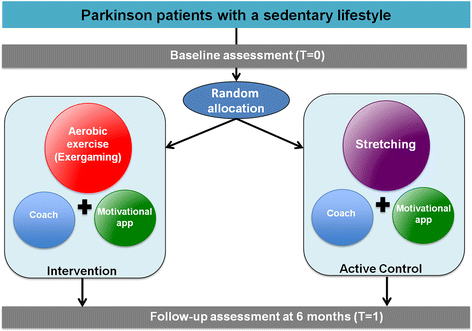Design of the Park-in-Shape study: a phase II double blind randomized controlled trial evaluating the effects of exercise on motor and non-motor symptoms in Parkinson's disease
- PMID: 25880966
- PMCID: PMC4418070
- DOI: 10.1186/s12883-015-0312-6
Design of the Park-in-Shape study: a phase II double blind randomized controlled trial evaluating the effects of exercise on motor and non-motor symptoms in Parkinson's disease
Abstract
Background: Parkinson's disease (PD) is a neurodegenerative disorder with a wide range of motor and non-motor symptoms. Despite optimal medical management, PD still results in a high disability rate and secondary complications and many patients lead a sedentary lifestyle, which in turn is also associated with a higher co-morbidity and mortality. Exercise has been explored as a strategy to reduce secondary complications and results suggests that it not only provides general health benefits, but may also provide symptomatic relief. If this holds true exercise would be a very attractive addition to the therapeutic arsenal in PD. The supportive evidence remains incomplete. Here, we describe the design of the Park-in-Shape study, which primarily aims to evaluate whether aerobic exercise affords clinically relevant improvements in motor symptoms in sedentary PD patients. A specific new element is the introduction of gaming to optimize compliance to the exercise intervention.
Methods/design: The Park-in-Shape study is a randomized controlled, assessor- and patient-blinded single center study. Two parallel groups will include a total of 130 patients, receiving either aerobic exercise on a home trainer equipped with gaming elements ("exergaming"), or a non-aerobic intervention (stretching, flexibility and relaxation exercises). Both groups are supported by a specifically designed motivational app that uses gaming elements to stimulate patients to exercise and rewards them after having completed the exercise. Both interventions are delivered at home at least 3 times a week for 30-45 minutes during 6 months. Eligible patients are community-dwelling, sedentary patients diagnosed with mild-moderate PD. The primary outcome is the MDS-UPDRS motor score (tested in the off state) after 6 months. Secondary outcomes include various motor and non-motor symptoms, quality of life, physical fitness, and adherence.
Discussion: This Park-in-Shape study is anticipated to answer the question whether high intensity aerobic exercise combined with gaming elements ("exergaming") provides symptomatic relief in PD. Strong elements include the double-blinded randomized controlled trial design, the MDS-UPDRS as valid primary outcome, the large sample size and unique combination of home-based pure aerobic exercise combined with gaming elements and motivational aspects.
Trial registration: Dutch trial register NTR4743.
Similar articles
-
Effectiveness of home-based and remotely supervised aerobic exercise in Parkinson's disease: a double-blind, randomised controlled trial.Lancet Neurol. 2019 Nov;18(11):998-1008. doi: 10.1016/S1474-4422(19)30285-6. Epub 2019 Sep 11. Lancet Neurol. 2019. PMID: 31521532 Clinical Trial.
-
Current Perspectives on Aerobic Exercise in People with Parkinson's Disease.Neurotherapeutics. 2020 Oct;17(4):1418-1433. doi: 10.1007/s13311-020-00904-8. Neurotherapeutics. 2020. PMID: 32808252 Free PMC article. Review.
-
Design of the STEPS trial: a phase II randomized controlled trial evaluating eHealth-supported motor-cognitive home training for Parkinson's disease.BMC Neurol. 2023 Oct 4;23(1):356. doi: 10.1186/s12883-023-03389-y. BMC Neurol. 2023. PMID: 37794320 Free PMC article.
-
Study in Parkinson's disease of exercise phase 3 (SPARX3): study protocol for a randomized controlled trial.Trials. 2022 Oct 6;23(1):855. doi: 10.1186/s13063-022-06703-0. Trials. 2022. PMID: 36203214 Free PMC article.
-
GLP-1 receptor agonists for Parkinson's disease.Cochrane Database Syst Rev. 2020 Jul 23;7(7):CD012990. doi: 10.1002/14651858.CD012990.pub2. Cochrane Database Syst Rev. 2020. PMID: 32700772 Free PMC article.
Cited by
-
Alexa, let's train now! - A systematic review and classification approach to digital and home-based physical training interventions aiming to support healthy cognitive aging.J Sport Health Sci. 2024 Jan;13(1):30-46. doi: 10.1016/j.jshs.2023.01.004. Epub 2023 Feb 1. J Sport Health Sci. 2024. PMID: 36736727 Free PMC article.
-
Covid-19 and Parkinson's disease: an overview.J Neurol. 2021 Dec;268(12):4415-4421. doi: 10.1007/s00415-021-10721-4. Epub 2021 Jul 27. J Neurol. 2021. PMID: 34313818 Free PMC article. Review.
-
Camera-based objective measures of Parkinson's disease gait features.BMC Res Notes. 2021 Aug 26;14(1):329. doi: 10.1186/s13104-021-05744-z. BMC Res Notes. 2021. PMID: 34446098 Free PMC article.
-
Guide to Decomposition of Causal Effects Into Mediation, Interaction, and Direct Effects: Case Study on Aerobic Exercise and Parkinson Disease.Neurology. 2024 Jul 9;103(1):e209547. doi: 10.1212/WNL.0000000000209547. Epub 2024 Jun 10. Neurology. 2024. PMID: 38857471 Free PMC article.
-
High-Intensity Interval Cycle Ergometer Training in Parkinson's Disease: Protocol for Identifying Individual Response Patterns Using a Single-Subject Research Design.Front Neurol. 2020 Oct 22;11:569880. doi: 10.3389/fneur.2020.569880. eCollection 2020. Front Neurol. 2020. PMID: 33193011 Free PMC article.
References
-
- Tomlinson CL, Patel S, Meek C, Clarke CE, Stowe R, Shah L, et al. Physiotherapy versus placebo or no intervention in Parkinson’s disease. Cochrane Database Syst Rev. 2012;8:CD002817. - PubMed
-
- Mehrholz J, Friis R, Kugler J, Twork S, Storch A, Pohl M. Treadmill training for patients with Parkinson’s disease. Cochrane Database Syst Rev. 2010;1:CD007830. - PubMed
Publication types
MeSH terms
Associated data
LinkOut - more resources
Full Text Sources
Other Literature Sources
Medical
Research Materials
Miscellaneous


